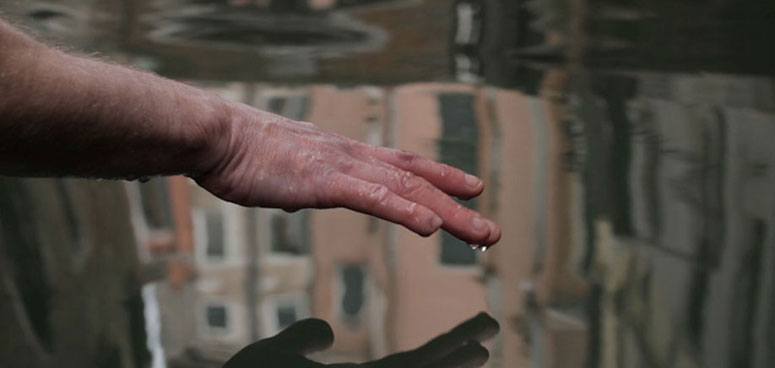
by Philomena Epps
FOLD Gallery is currently showing a solo exhibition by Tim Davies until 22nd of December. Davies lives and works in Swansea and was chosen to represent Wales at the 54th Venice Biennale in 2011. As a researcher, artist and curator, his work is often conceptual and site responsive, using an array of mediums to examine conventions surrounding cultural temporality and its relationship to landscape and architecture.
The exhibition title, In and Amongst, references the fundamental sense of harmony, unity and aesthetic beauty in his work. Despite a diverse and wide ranging use of media and materials, these themes remain transcendent. The seven pieces in the exhibition, a selection of two dimensional and video works, contribute to an overriding narrative about the relationship between nature and human activity.
There is a fiercely performative element to his practice. Davies is evidently an artist fascinated with the process of making, unmaking, constructing and deconstructing. His aesthetic is minimalistic and precise, almost scientific in its execution. Many of the works are site specific in their origins, serving to reiterate an interest in and questioning of the cultural and social conventions that surround perceptions of landscape and architecture.
Bridges (2009 onwards) is a series of 48 sanded postcards that occupy one wall of the gallery. The obsessive nature to his work is notable here, the repetition of the rubbings and scratching become tied into the aesthetic of the pieces themselves. The bridges are isolated from any form of landscape; the viewer is denied knowledge of the places that the bridges were built to connect. Displaced and severed from their original context, they are rendered dysfunctional, only to be valued on their appearance. A similar method operates in the Belief Systems Architecture series (2012) where a laser cutter has been used to create circular incisions in a series of images of skyscrapers and large architectural structures from across the world. These are reminiscent of the ‘Anarchitecture’ movement advocated by Gordon Matta Clark. The cuts are able to alter and deconstruct the structure entirely. In a troubling manner, it is mathematics and geometric perfection that forces the buildings to collapse and break down. This element of violence reoccurs in Scattered (2000/2012), a series of large wooden panels scorched to create abstract patterns.
Davies’s video work holds an elegiac and simplistic quality. Kilkenny Shift (2009) depicts a journey ascending a tower through a series of collaged stills. The stills concentrate on the steps themselves, reducing everything to monochrome grainy elements that appear in sequence almost silently until they are broken by a final, loud, colourful descent. The multiplicity of the postcards and panels are echoed by four small screens displaying Chase (Xiamen) (2012). Inspired by world travels, the landscape of busy Xiamen is muted, the films shift in and out of focus. The landscape is rendered both familiar and strange as the screens show the same film on a loop but in changing sequence. The eerie silence of Chase is echoed in the large projection of Drift (2011). Davies explained this work as an attempt “to touch the illusive icon of Venice”. The film focuses on a disembodied hand playing with canal water and the landscape is only visible in the rippling reflections.
A sense of the uncanny lingers behind the perfection and precision in Davies’ work. Human activity is portrayed as able to negotiate both architecture and nature. Panels are burnt and scorched; hands drift through water; postcards are cut and scratched. To Davies, the repetition of certain gestures is a form of action that is “necessary to physically, in a very real sense, explore, uncover and alter meanings…a way of teasing out semantic potential”. These anthropological musings force the viewer to meditate on the relationship between our natural environment and the solutions we have developed to coexist within an often unruly or unpredictable world.
Davies’ work is represented in private collections and in the Arts Council Collection at the Southbank Centre, London; the National Museum of Wales, Cardiff; the Glynn Vivian Gallery, Swansea; the National Library of Wales, Aberystwyth; the Harris Museum, Preston and the British Council Collection.